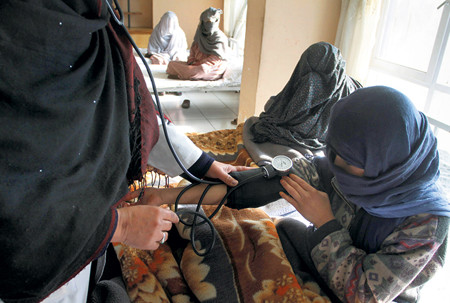By Aunohita Mojumdar in Kabul
Mariana lies on her bed in the Sanga Amaj clinic in Kabul. She shares a small ward with 12 women enrolled in the clinic's 45-day residential drug rehabilitation programme. At 22, she is five months pregnant with her fourth child. Her one-year-old son lies in a separate room of the clinic. He is also addicted to opium.

A doctor at the Sanga Amaj Centre in Kabul treats women addicts.
Mariana is one of an estimated one million Afghan adults addicted to illegal drugs, according to the latest survey from the United Nations Office on Drugs and Crime (UNODC). At 8 per cent of the adult population, this is twice the global average. Mariana's opium dependence was not a result of recreational experimentation. She is one of the estimated thousands of Afghan women dependent on the outlawed and highly addictive painkiller because they cannot access medicines or medical help. In Mariana's case, it started four years ago after she gave birth. "During the birth of my first child I lost a lot of blood. There was no doctor. After that I had a lot of pain in my legs and my back, but we couldn't afford medicines," she says.
Opium paste, though banned, can be bought under the counter at small shops in most bazaars here and throughout Kabul. The opium latex is boiled and distilled into a thick sticky paste the consistency of putty and chewed like tobacco. "I started taking some opium paste with my tea," says Mariana. "Without the opium to dull my pain I could not clean, cook or look after my baby. Over the past year I have become deeply addicted and need to take the opium every day."
Afghanistan produces more than 90 per cent of the world's opium and heroin. About 123,000 hectares are given over to farming the poppies used to process the drugs, according to UNODC's 2010 survey. Years of efforts by the UN, the US and other nations to wean Afghan farmers off opium cultivation have failed. Output fell this year after the crops were hit by disease, but UNODC has warned output is likely to rise again.
Southern Afghanistan, the most volatile part of the country, accounts for 87 per cent of production. The bulk of this comes from Kandahar and Helmand provinces, where international military forces have been engaged in intense battles to oust the Taliban. "These regions are dominated by insurgency and organised crime networks," said the UNODC executive director, Yuri Fedotov.
Mariana explains that, unable to cope with the demands of three children, she began giving the opium to her youngest child to lull him to sleep. As a result, her baby son also became addicted and was enrolled in the programme. "There is traditional use of opium to calm children," says Gilberto Gerra, chief of the drug prevention and health branch of the UNODC. "It is difficult to distinguish between traditional use and addictive use. Many people are not aware of becoming addicted and they go from the grey area to the black area."
The latest statistics show a huge leap in the rate of addiction since the last survey in 2005. While opium use has increased by about 53 per cent, the proportion of heroin users has increased by 140 per cent due to the cheap availability of both drugs. UNODC says the true numbers of women addicts is likely to be much higher. Only 3 per cent of those interviewed for UNODC's survey were women.
"Cultural constraints also prevent access to women," says Sarah Waller, a drug demand reduction consultant with the UNODC. "Women tend to use drugs in their homes. They are an extremely hidden population."
Mariana is unusual in that her family allowed her to enrol in a residential clinic. "It is very difficult to convince families to let them complete the course," says Dr Latifa Hamidi, a co-ordinator at the Sanga Amaj clinic. The clinic does not advertise its location to ensure its security, and visits by outsiders such as journalists are carefully monitored.
While much investment has gone into trying to curb production, there has been less attention on the problem of addiction. "The treatment gap is enormous," Ms Waller says. There are only 40 treatment centres with a maximum capacity of 760 beds, though they can cater to 10,000 addicts, including through outpatient facilities as well as home-based care.
Robert Watkins, deputy special representative of the UN Secretary-General, points out that the causes of addiction require as much attention as treatment. "We also have to spend a lot of time looking at the root causes, and those are much more challenging and difficult to overcome, strongly rooted in poverty and the inability to access treatment not just for addiction but other ailments."
"Short-term funding for up to a year is not really a solution. Sustainable, longer-term funding solutions have to be sought," Ms Waller says. The risk of relapse is very high if patients go back to the same conditions which led to the drug addiction in the first place, points out Gilberto Gerra. Sustainable livelihoods need to complement drug reduction programmes.
Solutions in Afghanistan need to be tailor-made to the situation. They have to include not just medical treatment for physical addiction, but also for dealing with mental health issues of a population traumatised by a conflict that shows no sign of ending.



